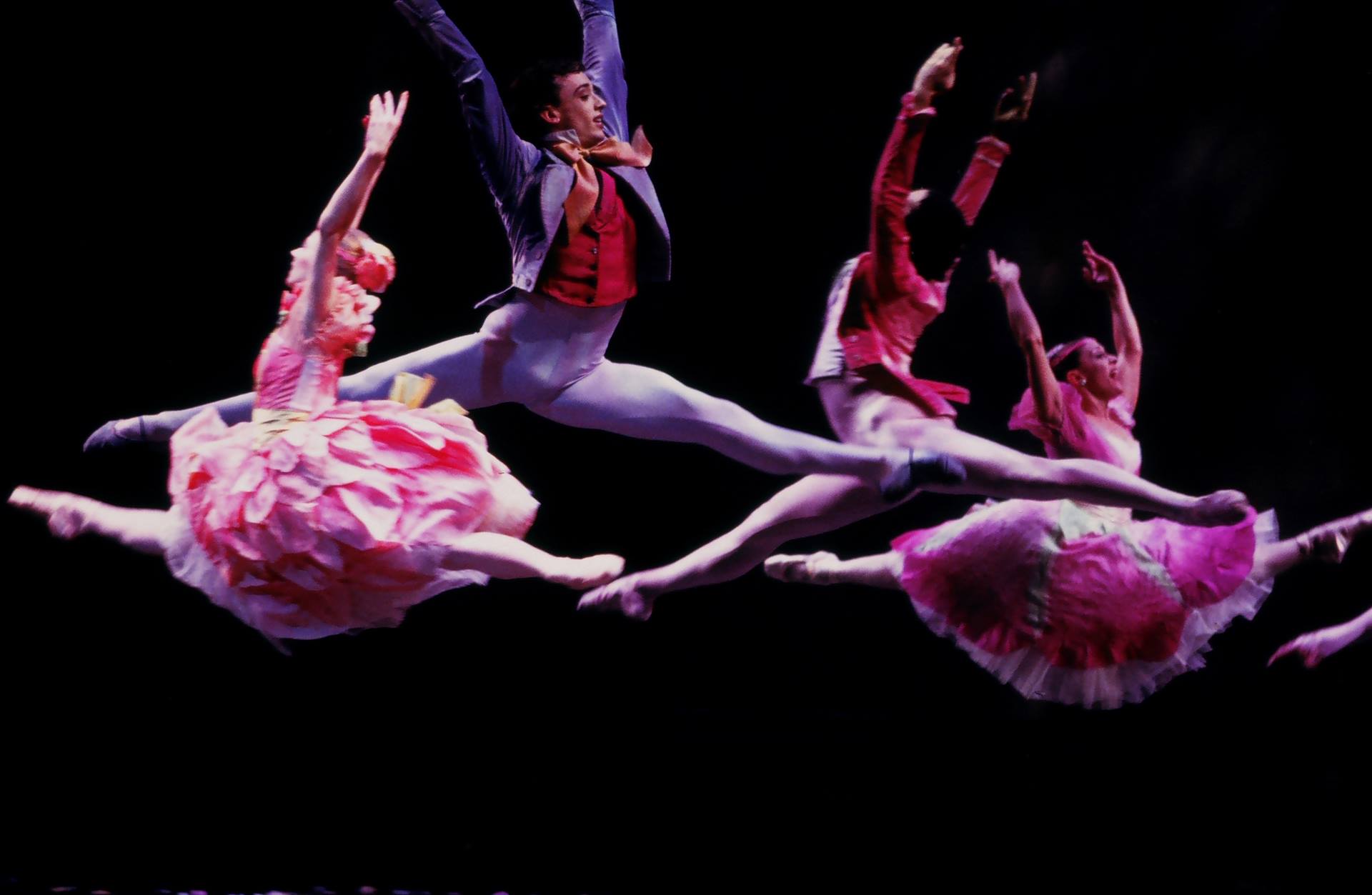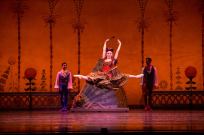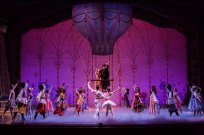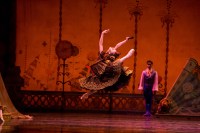CHICAGO — Nicole Ciapponi pops off her boot and rolls down her sock, revealing a large mass on the inside of her right foot. A four-inch scar runs across the bump. The wad of scar tissue protrudes at a right angle; it doesn’t make sense that she walks so easily in those high heeled boots. She sits on a well-worn couch in the physical therapy room at the 126-year-old Auditorium Theater between two performances of the Joffrey Ballet’s Nutcracker. Earlier that day, the company performed for a large group of Chicago Public Schools students. Later that night, they would perform the well-known ballet for a packed house.
Pyotr Tchaikovsky debuted the Nutcracker in 1892 in St. Petersburg, Russia. Even if you don’t know Tchaikovsky from Gronkowski, your head has been filled with music from the Russian dance or the Dance of the Sugar Plum Fairy in commercials or in department stores during the holidays.
On opening night of the Joffrey Ballet’s Nutcracker, Ciapponi danced the solo Spanish divertissement, acting as one of the many gifts given to Clara on her magical trip through the Land of Sweets. Wearing a costume of layers and layers of black and gold lace and carrying a black lace fan, she transformed from a 22-year-old in jeans to a dancer worthy of young Clara’s dreams. She did this even though her foot was held together by a screw earlier in the year. Over the Joffrey’s 33 Nutcracker performances, she will play the Spanish dancer, a snowflake in the Land of Snow, a dahlia in the Waltz of the Flowers, and a Mechanical Doll in the party scene before Clara gets her Nutcracker doll.
As families crowd into the theater and 7-year-old children gaze up to the stage, they want to see the magic of the Nutcracker. They know nothing of the pain dancers may be feeling.
Over a period of two years, I had been dancing with about seven fractures in my foot, and I thought it was tendinitis. I was oblivious.
Nicole Ciapponi
The screw that kept her foot together caused Ciapponi to limp, so she had it removed. The pain and uncertainty that came with that surgery made Ciapponi wonder if she had to start rethinking her career. She had no idea if her body could recover and become strong enough to do what she had spent 16 years training to do. Since she is Canadian, even her ability to stay and dance in the United States was in question.
“Over a period of two years, I had been dancing with about seven fractures in my foot, and I thought it was tendinitis,” Ciapponi says. “I was oblivious. It was in my Lisfranc joint. I had seven fractures, six bone chips and a tendon that was just not there.”
Lisfranc injuries frequently knock NFL players off the field, sometimes for as long as an entire year and have in rare cases ended careers.
Yet throughout December, Ciapponi — pronounced chee-A-pony — flew across the stage as the Spanish dancer in the Joffrey Ballet’s staging of “The Nutcracker.” The role requires her to dance en pointe, rolled up on to the very tips of her toes. She also has to do several leaps and spins, asking her feet to support her lithe frame as it whipped around. The mass on her foot was hidden by ballet shoes, obscured to the many fans who yelled bravo when she finished her solo.
Ciapponi, like the other members of the Joffrey and top companies across the country, is not just an elegant and beautiful dancer. She is an elite athlete. Watch her practice and perform and you will not doubt that.
After a heated game with the New York Giants, Carolina Panther Cortland Finnegan ripped the Giants’ star receiver, Odell Beckham, Jr. He said Beckham, who was whistled for three personal fouls in the Panthers’ win, started troubles between the two teams by walking through the Panthers’ warm-up like a “ballerina.” Finnegan, who is known for his trash talking, meant the term pejoratively.
He must not know how much he shares in common with the world’s elite ballet dancers.
The backstage of the massive Auditorium Theater doesn’t much resemble an NFL sideline. Painted sets and props are everywhere, including the rafters, where a giant marionette used in “The Nutcracker” resides. A papier-mache nutcracker head is perched on a shelf, next to an oversized mouse head. Glitter is everywhere.
Yet Ashley Wheater, the artistic director of the Joffrey Ballet, is very much the coach of this company of 41 dancers. The words that come out of his mouth could easily be from Pete Carroll or Gregg Popovich. He sets the tone for the company, evaluates his dancers’ performances, and decides casting. As a former dancer himself, Wheater understands the pressures and joys of performing. Like Ciapponi, he still bears the scars of his dancing days.
In 1996, he was trying a new lift during rehearsal with the San Francisco Ballet. Lifts are common in ballet, but often rely on the male dancer’s leg and arm strength to gracefully achieve the hoisting of a female partner. A German choreographer wanted Wheater to try something different, and it resulted in the end of his career.
“I was asked to pick someone up on my head from the floor, without using my arms. So, their entire body weight was on my head, and it was just too much. My disks couldn’t cope,” Wheater says. “It was really painful.”
Doctors told him they needed to operate, and the surgery would end his career. After dancing under Rudolf Nureryev — a pioneer in ballet who changed it as much as Steph Curry has changed the NBA — and starring in San Francisco, Australia and the Joffrey, his career was suddenly over.
He began teaching nearly immediately. He taught his first classes with the San Francisco Ballet while still wearing a halo neck brace. Ten years later, the Joffrey hired him.
An artistic director focuses the direction of the ballet company, hiring teachers and casting dancers, choosing ballets to perform, and oftentimes, serving as the choreographer. Those many roles mean some directors are not as present with their dancers.
Wheater is a hands-on leader. He works with choreographers to stage his ballets and refines their work with his company.
“I want to be in the studio with the company every day, so I am. I teach them. We have technique class every day,” he says. “I coach them, I give them all the tools to support them, and the tools to demand more from them.”
In the fall, that challenge led the Joffrey to stage “Millennials,” a new program that pushed its dancers to difficult limits as they had to learn a totally new ballet with new music and new choreography. The result was a program the Chicago Tribune called “ambitious” and “impressive.”
The Joffrey is considered an all-star ballet, so there is not a strict ranking of dancers, like in the New York’s American Ballet Theater, where Misty Copeland made headlines earlier this year when she was the first African-American dancer promoted to principal dancer. There is a hierarchy for more experienced dancers, but Wheater says the set-up at the Joffrey allows for teamwork.
“I’m a big believer in giving people opportunities to try different things,” he says. “I think that knowing that, within the team, people are there to support each other, because they knew that they had the opportunity, so they want to support the other person.”
In his 13th season with the Joffrey, Derrick Agnoletti is one of Wheater’s more experienced dancers. With a short frame, powerful legs and a muscular chest, he could easily be mistaken for a wrestler. Instead, Agnoletti uses those legs to propel himself across the Auditorium’s stage in his role as one of the Russian dancers, requiring quick movements with leaps high enough to make you wonder what he could do with a basketball in his hand.
Agnoletti started his athletic life in the pool. As a Californian from a family of swimmers, he was in the pool before he could walk. He swam competitively and played water polo through college. But he knew he was always destined to dance.
His swim coach told him to take a dance class when he was eight years old to improve coordination.
“I remember walking in the room, and this sounds so cliche, but I remember walking in the room, seeing the class before me finishing, hearing the piano, and how everything was almost mathematical and geometrical and everybody was so expressive, and I thought, This is what I’m going to do,” he says.
Sports are still part of Agnoletti’s life. Wheater is a proponent of cross-training for his dancers, and Agnoletti embraces this. He swims three times a week, and says ESPN is always on in his home. He sees athletes who could have easily followed his path and excelled as a dancer.
“Patrick Kane is one of the most inspirational athletes. Watching him on the ice is elegant. It’s insanely beautiful,” Agnoletti says. “Then to see how rough the game is, for him to demonstrate the amount of elegance in his technique and his stick-handling, it’s unreal.”
“Years ago, I used to look at Kobe Bryant, he’s so long and elegant, and I thought he would be such a beautiful ballet dancer. Brian Boitano, I always saw his carriage and usage of arms were quite expressive, so I’m sure he had some ballet training. The quarterback that failed the Niners, Colin Kaepernick, I feel as though he would have been a great dancer because of his build.”
The Chicago Bears play in Soldier Field, about a mile from where the Joffrey performs. When injuries hit the Bears’ offensive line, Kyle Long was moved to tackle from guard and the promising young players was forced to learn a new role quickly. It wasn’t easy for him — or quarterback Jay Cutler — but the Bears had to make the line work with the personnel they had.
This next-man-up philosophy comes into play every day at the ballet. The Nutcracker runs throughout the month of December, sometimes with two performances a day. The dancers have several roles throughout the run, keeping them fresh. Sometimes, changes must be made at the last minute.
Edson Barbosa, a young dancer who shares his name and home country of Brazil with a UFC fighter, found this out during the Nutcracker. The ballet is familiar to dancers because it is staged by nearly every ballet company every holiday season, so they can jump into roles they have never danced before after simply watching it in rehearsals and performances. He already knows the base elements — the technique he needs for a pirouette doesn’t change from role to role — but that doesn’t mean it’s easy.
“Last week, I had a surprise new role. They said, ‘Edson, can you step in for this spot you’ve never done before? You go tomorrow.’ It’s part of the job. Sometimes, it’s something you’ve never done before, but you have an idea, because you’ve watched it before,” Barbosa says.
To be a successful dancer, it’s a mix of technique, and how you treat your body. I’ve seen dancers’ careers end at 32, 33.
Edson Barbosa
He found his way to dance when a ballet school director in Rio de Janeiro visited his school. His father wanted him to do karate, but Barbosa was hooked on dancing.
He is just 21, but like many college basketball players considering their professional careers, Barbosa thinks about how he must treat his body to ensure a long run. Ballet dancers can last until their early 40s.
“To be a successful dancer, it’s a mix of technique, and how you treat your body. I’ve seen dancers’ careers end at 32, 33, and I’ve seen dancers retire when they are 45,” he says. “It’s great. It means that he’s a really good dancer, and he respected his body. It’s our machine.”
Barbosa, Agnoletti and Ciapponi all touched on the key to staying healthy and strong throughout the long season: class. The Joffrey’s company classes cover warming up and technique, but aren’t mandatory. Think of it as batting practice or a shoot around. Coming to class helps dancers focus beyond performances and rehearsals.
Ciapponi once hated class, but after dealing with injuries, she revels in going.
“When I take class, I feel like it’s strengthening me. When I used to dance in San Francisco, I thought, I don’t need class! I was young. And now, I can’t even imagine not taking class. And it’s probably why I got injured. I never took class, and I would just perform,” Ciapponi says.
Those injuries led Ciapponi to the edge of her dance career as she went through three surgeries. There are 26 bones in the human foot. She had fractures in seven of them. Her Lisfranc joint was not doing of its job of holding the foot together. She could barely walk after scar tissue amassed in one foot, much less dance.
She had to move back in with her parents in Canada and deal with the visa issues that come with being a Canadian citizen working in the United States. She was in pain and unsure of her ability to dance again on the foot that had betrayed her after supporting her for so many years. Somehow, Ciapponi remained confident, and she worked her way back to en pointe.
Two weeks before the Joffrey was set to start rehearsals for the 2015-16 season, Wheater called her with a contract offer.
Now she’s back to dancing, and back to the rituals that get her ready for performance. Like a baseball player working his glove until it fits just so, Ciapponi readies her toe shoes. She goes through a new pair every performance, and the shoes don’t come out of the box ready to go.
It’s two weeks before Christmas. Chicago still isn’t cold enough to feel like winter, but the city’s holiday events are in full swing. Revelers are drinking beer from a boot at Christkindlmarket underneath the Picasso Statue in Daley Plaza, a giant Christmas tree is lit up next to the Bean in Millennium Park, and at the Auditorium, Ciapponi is scheduled to don the black and gold dress of the Spanish dancer again.
In the bowels of the 126-year-old theater, she gets to work. Ciapponi unwraps her pair of custom shoes. She cuts them, and removes a back nail. Next, she slices the back open, and sews it back up in a specific pattern she has honed over years of dancing.
It’s a ritual. At the Nutcracker, little girls in sparkly, tulle dresses marvel at giant pictures of dancers and ask their parents to buy ornaments of dancers and nutcrackers. Marble concession stands sell sugar cookies and Nutcracker-themed drinks. At intermission, patrons run out to the lobby to mingle and eat. Dancers paint their faces and dress in colorful costumes to get into character.
At Soldier Field, young fans in Bears jerseys marvel as Jay Cutler and Matt Forte warm up on the field, and fill up on soda pop and pizza at halftime. Players trace eyeblack on their face and don jerseys to show their allegiance.
This too, is a ritual, a part of the way top athletes use their bodies to express themselves. The difference between fouettes and grand jetes on the stage and spin moves and flying catches in sports are of degree, not kind. An NFL player may tip-toe like a ballerina but the ballerina will surely explode up off the ground and soar through the air with astonishing grace, landing gently on a foot full of scar tissue.













